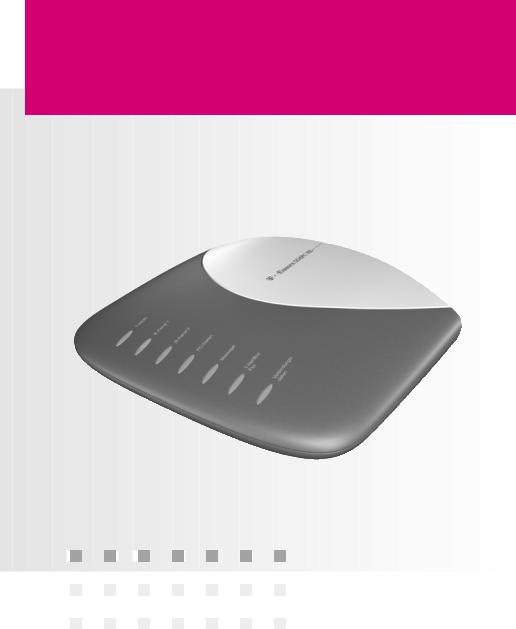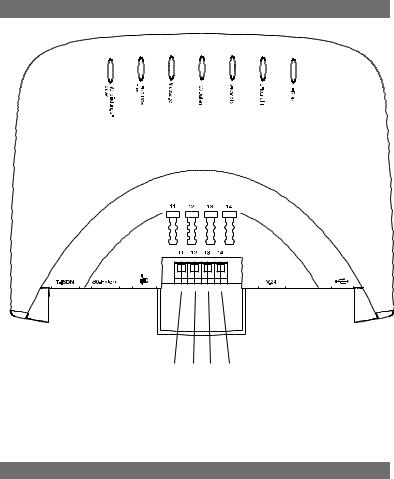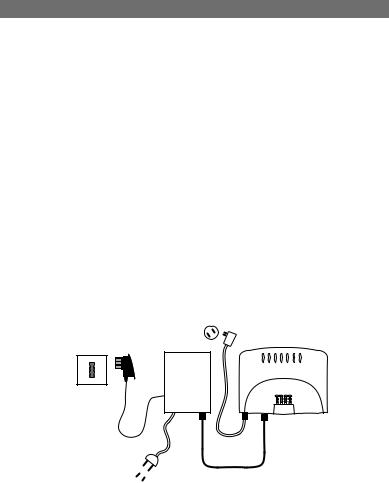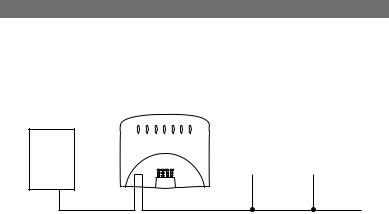Deutsche Telekom T-Eumex 504PC SE User Manual

===!T§ Deutsche Telekom
User Guide
T-Eumex 504PC SE
The Communications System with Automatic Internet Access and Firewall Functionality.
Before You Install or Operate Your Eumex 504PC SE...
a…please make sure you read the instructions in this user guide. The law requires us to inform you about important safety precautions, both for your own safety and to avoid damage to your equipment.
If you ignore this guide, Deutsche Telekom will not accept any liability for damages resulting from negligent or wilful disregard of the instructions contained in it.
Only equipment supplying safety extra low voltage (SELV) and/or complying with standard ETS 300 047 should be connected to the Eumex 504PC SE. Equipment operated in accordance with its purpose complies with this regulation.
Do not open the housing yourself. Unauthorised opening of the housing and improper repairs may endanger the user. In addition, the warranty will be invalidated.
Do not allow fluids to penetrate inside the Eumex 504PC SE, as this could result in short circuits or electric shocks.
Please commission your Eumex 504PC SE as described in the section on Mounting and Commissioning.
a b d c
Symbols Used
General note
Important safety precautions
Lift the handset Replace the handset Hold your conversation
tDial telephone number or select code digit
q g k
You hear an acknowledgement tone
Your telephone rings
3-party conference
rPress the R-key (aka the flash or enquiry key)
*Use the star key to activate or deactivate a feature
#Use the hash key to quit programming
1to 0 Dial specific digits.
Contents
General ............................................................................................................. |
1 |
A Word of Welcome.................................................................................................................. |
1 |
The Features of the Eumex 504PC SE .................................................................................. |
2 |
Supported ISDN Features ....................................................................................................... |
3 |
Safety Precautions.................................................................................................................... |
4 |
Power Failure ............................................................................................................................. |
4 |
Mounting and Commissioning ........................................................................... |
5 |
Scope of Delivery...................................................................................................................... |
5 |
What Does the Eumex 504PC SE Require?......................................................................... |
6 |
Mounting and Installation Sequence .................................................................................... |
7 |
Mounting Location.................................................................................................................... |
8 |
Choosing a Location for Your Eumex 504PC SE................................................................. |
9 |
Tools for Wall Mounting ........................................................................................................... |
9 |
Wall Mounting............................................................................................................................ |
9 |
Connecting Devices......................................................................................... |
10 |
Connection Diagram.............................................................................................................. |
10 |
Connecting.............................................................................................................................. |
10 |
Connecting the Eumex 504PC SE to T-ISDN..................................................................... |
11 |
Connecting Analogue Terminals to the Eumex 504PC SE ............................................. |
12 |
Connecting a Computer to the Eumex 504PC SE............................................................ |
12 |
Connecting the Eumex 504PC SE to the Power Supply.................................................. |
13 |
Additional Terminals on the S0 Bus .................................................................................... |
15 |
Interpreting the LEDs ............................................................................................................. |
16 |
Setting the Dialling Mode for the Analogue Terminals..................................................... |
16 |
Commissioning................................................................................................ |
17 |
The Eumex 504PC SE Default Settings on Delivery......................................................... |
17 |
Telephoning .................................................................................................... |
18 |
Accepting Calls....................................................................................................................... |
18 |
Automatic and Manual External Line Seizure.................................................................... |
18 |
Making Internal Calls ............................................................................................................. |
19 |
Making External Calls ............................................................................................................ |
20 |
Making Calls Using Speed Dialling..................................................................................... |
21 |
Enquiry Calls ........................................................................................................................... |
22 |
Transferring Calls (ECT) without an Announcement ........................................................ |
23 |
Transferring Calls (ECT) with an Announcement.............................................................. |
24 |
Speaking with Two Subscribers Alternately (Toggling).................................................... |
25 |
Speaking with Two Subscribers Simultaneously (3-party Conference) ........................ |
26 |
Picking up Calls...................................................................................................................... |
27 |
Picking up Calls from an Answerphone ............................................................................. |
27 |
Automatic Callback on Busy ................................................................................................ |
27 |
Automatic Callback on No Reply......................................................................................... |
28 |
DTMF Post-dialling ................................................................................................................. |
29 |
Contents
Malicious Call Identification (MCID).................................................................................... |
29 |
Calling Your T-NetBox............................................................................................................ |
29 |
Staying in Touch .............................................................................................. |
30 |
Call Forwarding ...................................................................................................................... |
30 |
Activating Call Forwarding.................................................................................................... |
30 |
Deactivating Call Forwarding ............................................................................................... |
31 |
Accepting or Rejecting Call Waiting.................................................................................... |
32 |
Activating Call-waiting Protection ........................................................................................ |
33 |
Deactivating Call-waiting Protection ................................................................................... |
33 |
Day/Night Line Switchover ................................................................................................... |
34 |
Special Settings/Features................................................................................ |
35 |
Blacklist.................................................................................................................................... |
35 |
Call Through............................................................................................................................ |
36 |
Using Call Through ................................................................................................................ |
36 |
External Access Rights and Speed-dialling Numbers ..................................................... |
37 |
Emergency Numbers............................................................................................................. |
38 |
Charge Limit (Charge Account) ........................................................................................... |
38 |
Call Data................................................................................................................................... |
38 |
Configuration via Telephone ............................................................................ |
39 |
Starting the Configuration Mode ......................................................................................... |
40 |
Exiting the Configuration Mode ........................................................................................... |
40 |
Editing the PIN ........................................................................................................................ |
41 |
Storing Telephone Numbers (MSNs) .................................................................................. |
42 |
Call Assignment...................................................................................................................... |
43 |
Manual External Line Seizure with 0 ................................................................................... |
45 |
Automatic External Line Seizure.......................................................................................... |
45 |
Number Busy .......................................................................................................................... |
46 |
Activating Number Busy........................................................................................................ |
46 |
Deactivating Number Busy ................................................................................................... |
46 |
Configuring the Device Type for the Internal Lines........................................................... |
47 |
External Line Access.............................................................................................................. |
48 |
Storing Emergency Numbers ............................................................................................... |
49 |
Deleting Emergency Numbers............................................................................................. |
49 |
Storing Numbers for Speed Dialling ................................................................................... |
50 |
Deleting Individual/All Speed-dialling Number Memory Locations .............................. |
50 |
Blocking/Releasing Speed Dialling for Internal Lines without External Line Access.51 |
|
Programming a Telephone Number (MSN) for Transmission ......................................... |
52 |
Always Call Anonymously (Restrict Telephone Number)................................................. |
52 |
Always Transmit Telephone Number (Restrict Telephone Number: Cancel) ............... |
53 |
Charge per Unit of Time ........................................................................................................ |
54 |
Resetting/Deleting the Charge Counter............................................................................. |
54 |
Setting a Charge Limit ........................................................................................................... |
55 |
Contents
Activating/Deactivating the Charge Limit .......................................................................... |
55 |
Managing Call Forwarding ................................................................................................... |
56 |
Activating Call Forwarding in the Exchange ...................................................................... |
56 |
Activating Call Forwarding in the Eumex 504PC SE ........................................................ |
56 |
Deleting All Call Forwarding................................................................................................. |
57 |
Activating/Deactivating Call Data Recording .................................................................... |
57 |
Activating/Deactivating Call Transfer (ECT)....................................................................... |
58 |
Call Transfer in a Communications system ........................................................................ |
58 |
Activating/Deactivating T-NetBox Signalling..................................................................... |
59 |
Activating /Deactivating Automatic Keypad Signalling.................................................... |
60 |
Resetting the Communications system .............................................................................. |
61 |
Restoring the Default System Settings................................................................................ |
61 |
Remote Configuration...................................................................................... |
62 |
Remote Configuration ........................................................................................................... |
62 |
The PC Software.............................................................................................. |
63 |
General .................................................................................................................................... |
63 |
System Prerequisites.............................................................................................................. |
64 |
About the Software................................................................................................................. |
65 |
Installing the Software ..................................................................................... |
66 |
Installing the Software ........................................................................................................... |
66 |
Configuring the System.................................................................................... |
68 |
Configuring the Eumex 504PC SE ...................................................................................... |
68 |
Menu: ISDN Telephone Numbers........................................................................................ |
69 |
Menu: Internal Lines .............................................................................................................. |
70 |
Menu: Call Assignment (Day/Night Line Switchover) ...................................................... |
71 |
Menu: Call Forwarding .......................................................................................................... |
72 |
Menu: Speed Dialling ............................................................................................................ |
74 |
Menu: Security – Filter Settings ........................................................................................... |
75 |
Menu: Network Settings ........................................................................................................ |
77 |
Menu: Additional Features.................................................................................................... |
78 |
Menu: Charges – Summary.................................................................................................. |
80 |
Menu: Charges – Call Data Records................................................................................... |
81 |
Menu: Saving/Loading .......................................................................................................... |
82 |
Connecting to and Disconnecting from the Internet .......................................... |
83 |
Connecting to the Internet .................................................................................................... |
83 |
Disconnecting from the Internet .......................................................................................... |
84 |
Contents
Starting a Program from the Windows Taskbar ................................................. |
85 |
Starting a Program from the Windows Taskbar................................................................. |
85 |
CAPI Control.................................................................................................... |
86 |
CAPI Control............................................................................................................................ |
86 |
FlashLoad ....................................................................................................... |
88 |
FlashLoad (Updating the Communications System Software)....................................... |
88 |
Teledat RVS-COM ............................................................................................ |
91 |
Basic Functions ...................................................................................................................... |
91 |
Program Modules................................................................................................................... |
91 |
Dialling Wizard Software.................................................................................. |
93 |
Win·Suite – Dialling Wizard – User Interface ..................................................................... |
93 |
Win·Suite – Dialling Wizard – Settings................................................................................ |
94 |
Call List ........................................................................................................... |
95 |
Win·Suite – Displaying the Call List..................................................................................... |
95 |
Win·Suite – Call List – Dialling from the Call List .............................................................. |
96 |
Appendix......................................................................................................... |
97 |
Audio Signals / Ringer Cadences ....................................................................................... |
97 |
Technical Specifications ....................................................................................................... |
98 |
Dealing with Faults ................................................................................................................. |
99 |
Customer Service................................................................................................................. |
100 |
Glossary................................................................................................................................. |
101 |
Declaration of Conformity................................................................................................... |
107 |
Returning Old Communications Systems........................................................................ |
107 |
Returning Your Old CD-ROM ............................................................................................. |
107 |
Warranty................................................................................................................................. |
107 |
Index of Key Words .............................................................................................................. |
109 |

General
A Word of Welcome
The Eumex 504PC SE is an ISDN communications system enabling you to connect up to four analogue devices to a basic ISDN connection.
In addition, the Eumex 504PC SE, in conjunction with the Teledat RVS-COM software supplied and a PC with a USB or V.24 interface, enables you to use data applications such as ISDN data transfer, transmission and reception of class 3 faxes, a mailbox terminal, answerphone functions and T-Online services.
Two completely separate external calls (e.g. a telephone call and a data application) can take place simultaneously on the two B-channels of an ISDN line. For example, you can have a telephone conversation while the connected PC is being used to surf the Internet.
The Eumex 504PC SE complies with the statutory regulations for telecommunications equipment. You are permitted to mount and install it yourself.
The Eumex 504PC SE should only be operated on an ISDN multi-terminal connection. It complies with the DSS 1 protocol. The Eumex 504PC SE is not designed for use on dedicated ISDN connections (system connection).
You can operate analogue devices with either dual tone multi-frequency (DTMF) dialling and a flash function or with pulse dialling on the Eumex 504PC SE.
A caller’s telephone number will only be displayed on telephones supporting this feature.
Please note: You require telephones with DTMF dialling and a flash function in order to be able to use the full range of Eumex 504PC SE features. Telephones with pulse dialling support neither the flash function (e.g. for enquiry calls) nor the star and hash keys for the control of features.
1

General
The Features of the Eumex 504PC SE
•10 multiple subscriber numbers (MSNs)
•Call waiting/call-waiting protection
•Call list for 50 calls (can be read on a PC)
•Call forwarding ("Immediately," "On busy," "After a (specified) time")
•Automatic callback ("On no reply" or "On busy")
•Call through to route incoming calls to external destinations
•CLIP (calling line number presentation) on analogue telephones
•Supports Doorline M06
•Dynamic B-channel handling
•Five levels of external line access
•Manual/automatic external line seizure
•Fax filter (blacklist for undesired fax reception)
•Internal/external call transfer
•Call transfer in a communications system (operation as a secondary system)
•Selective seizure of outgoing MSNs
•Call pick-up / pick-up from an answerphone
•Internet filter and/or blacklist for undesired Internet access and/or calls
•Port for connecting multi-purpose terminals
•Configuration via PC (Web Configurator and Windows user interface)
•Configuration via telephone
•Speed-dialling using speed-dialling codes or vanity function (name dialling)
•DTMF post-dialling
•Programmable emergency numbers (can always be dialled)
•Network adapter and firewall functionality for fast Internet access
•Enquiry calls / toggling
•USB and serial interface (V.24) to PC
•Supports SMS in wired network (corresponding telephone required)
•Saves up to 50 call data records / call data recording
•Day/night line switchover automatically switches over call assignment
2

General
Supported ISDN Features
•Call waiting / reject call waiting / accept call waiting with subsequent toggling
•Internal/external call forwarding ("Immediately," "On busy," "After a (specified) time")
•Presentation of the calling line number to the called line (CLIP)
•Transmission of the calling line number is restricted (CLIR)
•Presentation of the called line number to the calling line (COLP)
•Transmission of the called line number is restricted (COLR)
•3-party conference (two simultaneous 3-party conferences are possible)
•Malicious call identification (MCID)
•Holding (internal and external)
•Messages waiting in the T-NetBox are signalled visually (MWI)
•Toggling (internal and external)
•Multiple subscriber numbers (MSN, on a multi-terminal connection)
•MSN busy (busy on busy)
•Enquiry calls (internal and external)
•Automatic callback on busy (CCBS)
•Automatic callback on no reply (CCNR)
•Call forwarding by called party (CD)
•Advice of charge (AOCD/AOCE)
•Explicit call forwarding/transfer (ECT)
Please note:
Certain features must first be ordered from your telephone network provider before you can use them.
3

General
Safety Precautions
Do not open the housing. Unauthorised opening of the housing and improper repairs can endanger the user. In addition, the warranty is invalidated.
Do not continue using damaged or defective plugs or AC adapters with defective housings as these could cause electric shocks. Replace these components immediately with spare parts made by the same manufacturer.
Only equipment supplying safety extra low voltage (SELV) and/or complying with standard ETS 300 047 may be connected to the Eumex 504PC SE. Equipment operated in accordance with its purpose complies with this regulation.
Do not allow fluids to penetrate inside the Eumex 504PC SE, as this could result in short circuits or electric shocks.
Do not install the Eumex 504PC SE during a thunderstorm, or attach or remove cables, as this could lead to an electric shock.
The Eumex 504PC SE is designed for indoor operation only. Lay the cables so that they cannot be walked on or tripped over.
aDo not connect any devices that use the a/b lines for earthing to the analogue ports (TAE sockets, plug-in terminals). The a/b lines must not be connected to earth, as this could damage the device.
When connecting lines to the analogue ports, you must ensure that any existing shielding is not connected to earth.
Power Failure
Data backup: in the case of a power failure, all the data in the memory (program and user data) is retained without any changes. Merely the date and time are reset to their default settings when power is restored. The internal clock is automatically set to the correct time when the next charged call is made.
All callbacks are deleted.
You cannot telephone during a power failure.
4

Mounting and Commissioning
Scope of Delivery
Check to make sure that the contents of the package are complete:
•1 Eumex 504PC SE ISDN communications system
•1 plug-in AC adapter
•1 ISDN connector cable
•1 USB connector cable for PC
•1 CD-ROM with Windows 98/Me/2000/XP* installation software
•1 Eumex 504PC SE user guide (this document)
•4+1+1 brief user guides for analogue devices
•1 "Quick Installation" leaflet
•1 brief user guide entitled "Tips and Tricks"
•1 drilling template
•1 set of 6 mm rawlplugs and screws
Note
The special V.24 connector cable (for PCs running on Windows 95/NT4 operating systems) is not included in the delivery and is not available from Deutsche Telekom. This cable (part no. 4506.070) can be obtained from DeTeWe and must be ordered separately. Orders should be sent to fax no. 0049 30 6104 2662 or via e-mail to "ersatzteilservice@detewe.de."
On the CD-ROM you will find the following:
•The driver set-up software with the Common ISDN Application Programming Interface (CAPI), as well as CapiPort, CapiControl and the configuration software
•The complete ISDN software Teledat RVS-COM for Win 98/Me/2000/XP* for data transfer, class 3 and 4 faxes, PC telephony, answerphone function, and SMS in the wired network
•Deutsche Telekom’s T-Online software
*Windows 95/NT4 are also supported. However, there is no guarantee that the complete range of functions provided will be available (as these operating systems do not support USB).
5

Mounting and Commissioning
What Does the Eumex 504PC SE Require?
Certain prerequisites must be met for the smooth installation and operation of the Eumex 504PC SE, the configuration software and the Teledat RVS-COM communications package:
•You must have a basic Euro-ISDN connection with a network terminator (NTBA) as supplied by Deutsche Telekom (DSS 1). The Eumex 504PC SE is not designed to be operated on any other type of connection and any attempt to do so will lead to faulty operation.
•Only equipment supplying safety extra low voltage (SELV) and/or complying with ETS 300 047 may be connected to the Eumex 504PC SE. Equipment operated in accordance with its purpose complies with this regulation.
•In order to be able to use the full range of the Eumex 504PC SE features, you should only use analogue telephones with DTMF dialling and a flash function (70 - 330 ms).
The minimum system prerequisites for the installation of the Teledat RVS-COM communications software are as follows:
•IBM-compatible PC with hard disk and CD-ROM drive
•CPU speed of 233 MHz or faster
•64 MB RAM
•Microsoft Windows 98/Me/2000/XP*
•One free USB interface or
serial port (COM port) RS 232 (V.24).
* Windows 95/NT4 are also supported. However, there is no guarantee that the complete range of functions provided will be available, as these operating systems do not support USB. Connect PCs with these operating systems via the serial interface (V.24). This interface must be equipped with a UART 16550 chip enabling a data throughput of at least 115 kb/s. PCs built in or after 1996 generally have this chip. Please refer to your PC manual or ask your dealer or the manufacturer of your PC about this. In addition, the Eumex 504PC SE must already have been installed in accordance with the diagram in the chapter entitled "Connecting Devices" on
p. 10 ff.
Please note:
Before you install the Eumex 504PC SE driver software, you must first remove any existing ISDN card and uninstall any existing CAPI drivers.
6

Mounting and Commissioning
Mounting and Installation Sequence
The Eumex 504PC SE consists of various components. This User Guide first describes how to mount the communications system and how to connect terminals such as telephones. You can operate your equipment using the factory settings – you won’t miss a single call (see Default Settings on p. 17).
However, we recommend that you configure the Eumex 504PC SE according to your personal requirements before using it for the first time. You can configure the system via a telephone, or use a convenient, menu-driven configuration program on a connected PC. You can subsequently install the communications software on your PC.
The software is easiest to install on your PC before you connect the PC to the
Eumex 504PC SE (see the chapter entitled "Installing the Software," p. 66).
Please adhere to the following sequence:
1.Mount the Eumex 504PC SE and connect the devices as described in the following sections.
2.Configure the communications system. You can do this in three different ways
•PC configuration: menu-driven configuration via a PC. In order to do this, all the drivers on the CD supplied must be installed. Please refer to the chapter entitled "Installing the Software" on p. 66 for instructions on how to do this.
•Configuration via a telephone connected to your communications system. Please refer to the chapter entitled "Configuration via Telephone" for instructions on how to do this.
•Remote configuration: you can have your system remotely configured by TeleService for a fee.
For remote configuration, call: 0180 2 55 66 55.
PC configuration:
3.Install the CAPI driver. This procedure is described in the chapter entitled "The PC Software" on p. 63 ff.
4.Install and configure the Teledat RVS-COM communications software as described in the chapter entitled "Teledat RVS-COM" on p. 91.
With regard to points 2, 3 and 4 above, please note the system prerequisites listed in the section entitled "What Does the Eumex 504PC SE Require?"
In the Appendix you will find a glossary, an index of key words, and a diagram of the Eumex 504PC SE audio signals and ringer cadences.
7

Mounting and Commissioning
Mounting Location
The ambient operating temperature for the Eumex 504PC SE must not be lower than +5 °C or higher than +40 °C. For this reason, do not mount the Eumex 504PC SE
•above or in front of sources of heat (e.g. radiators),
•in direct sunlight,
•behind curtains,
•in small, unventilated rooms,
•outdoors,
•on or near inflammable material.
In addition, please ensure that
•the room is dry and as free of dust as possible,
•no high-frequency equipment (e.g. transmitters, radiation-emitting devices or similar) is nearby,
•no fluid can drop onto the Eumex 504PC SE and possibly penetrate inside the device through the ventilation slits,
•in the case of wall mounting, the wall is flat and capable of bearing the load.
The following criteria should be taken into account when selecting a mounting location:
•The availability of an earthed power socket for the plug-in AC adapter nearby.
•The length of the cables supplied. Please use the cable supplied for connecting via the USB interface. The communications system complies with the USB standard, which stipulates the use of cables not exceeding 5 m. Serial cables connecting to the V.24 interface must similarly not exceed 5 m.
•The length of the cables connecting the analogue devices must not exceed 300 m.
aIn order to exclude any possibility of danger to life or property, the earthed power socket for the 230 V~ mains supply must be installed by a qualified electrician.
8

Mounting and Commissioning
Connect the Eumex 504PC SE to a separate 230 V~ mains circuit. This prevents the communications system from being affected by possible short circuits in any other household equipment.
We recommend you to install a surge protector for protection against sudden high voltages such as those sometimes occurring during thunderstorms. Consult your electrician or Deutsche Telekom for advice.
Choosing a Location for Your Eumex 504PC SE
You can simply place the Eumex 504PC SE on a solid surface, e.g. a table. Please note that under certain circumstances the rubber pads on the base of the Eumex 504PC SE can leave unseemly marks on furniture.
Tools for Wall Mounting
You will require the following tools for wall mounting:
•6 mm masonry drill bit (the type of drill bit depends on the type of wall)
•Hammer or percussion drill
•Screwdriver (to fit the screws supplied)
Get the rawlplugs, screws and drilling template (all supplied) ready before you start mounting the device.
Wall Mounting
anear the planned drill holes, as these could be damaged.
Use the drilling template supplied and a 6-mm bit to drill holes for the two mounting screws 94.4 mm apart.
Insert the wall plugs and screw the screws into the wall so that a space of 4 mm between the head of the screw and the wall remains.
Place the mounting holes in the base of the Eumex 504PC SE over the screws, and pull downwards slightly.Make sure that there are no pipes, cables or similar objects running through the wall
9

Connecting Devices
Connection Diagram
|
|
|
|
|
|
|
|
|
|
|
External S0 |
|
|
|
|
|
|
|
|
T-ISDN |
AC adapter |
|
|
V.24 |
USB |
||||
|
|
|
1a/b 2a/b 3a/b 4a/b |
|
|
||||
|
|
|
Internaltelephonenumbers |
|
|
||||
|
|
11 |
12 |
13 |
14 |
|
|
|
|
Connecting
aDo not connect the Eumex 504PC SE during a thunderstorm, as this could lead to you getting an electric shock.
aLay all the cables so that they cannot be walked on or tripped over.
Ensure that the power and connecting cables are not bent, pulled, or in any way under mechanical pressure.
10

Connecting Devices
Connecting the Eumex 504PC SE to T-ISDN
Regulations permit the general public to connect the Eumex 504PC SE to the Deutsche Telekom network. You can thus connect the Eumex 504PC SE yourself if the following conditions are met:
•The device may only be connected to a basic Euro-ISDN connection. Do not under any circumstances connect it to lines or equipment in the analogue network. Never connect it to an ISDN tie line. Failure to observe these conditions can result in faulty operation or damage to the Eumex 504PC SE as well as to the network.
•The basic Euro-ISDN connection must be used in conjunction with a network terminator (NTBA) as supplied by Deutsche Telekom. The connection must be the multi-terminal type.
Insert the Eumex 504PC SE connector cable in the corresponding socket of the NTBA. Insert the other end in the socket marked "ISDN" on the bottom left-hand side of the Eumex 504PC SE.
230 V
TAE socket
NTBA Eumex
504PC SE
T-ISDN
 230 V
230 V
11

Connecting Devices
Connecting Analogue Terminals to the Eumex 504PC SE
You can connect up to four analogue terminals to your communications system.
We recommend you to deploy terminals that feature DTMF dialling and a flash function. Terminals with pulse dialling cannot perform functions requiring the R-key (e.g. enquiry calls), or the star or hash keys (e.g. setting features). Please refer to the section entitled "Setting the Dialling Mode" on p. 16.
You can connect the analogue terminals directly to the TAE ports on the EUMEX 504PC SE, or you can run 2-wire cable to remote TAE sockets. You will find the connectors beneath the semi-circular silver-coloured cover.
The cables connecting the Eumex 504PC SE to the analogue terminals must not be longer than 300m.
Connecting a Computer to the Eumex 504PC SE
Insert a serial connector cable or the correct end of the Eumex 504PC SE USB cable in the corresponding V.24 or USB socket 



 . Insert the other end in the corresponding socket on the PC.
. Insert the other end in the corresponding socket on the PC.
You do not need a computer to operate and configure the Eumex 504PC SE. However, a PC simplifies the system programming, while the communications software includes a range of further useful applications.
The software on the CD-ROM supplied is easiest to install on your PC before you connect it to the Eumex 504PC SE.
For further details, please refer to p. 66 ff.
12

Connecting Devices
Connecting the Eumex 504PC SE to the Power Supply
Connection to the 230V mains supply is not dangerous, providing you adhere strictly to the following instructions.
aDanger! Under no circumstances should you commission or continue operating the device if the AC adapter is damaged. Failure to observe this could result in loss of life due to an electric shock.
•Lay the AC adapter power cable so that it cannot be walked on or tripped over.
•Ensure that the power socket and AC adapter are easily accessible, so that the adapter can be removed from the socket quickly in case of danger! Removing the adapter from the socket is the only way of disconnecting the Eumex 504PC SE from the mains completely, as it does not have a power switch of its own.
•Never pull the adapter cable. If you want to disconnect the adapter from the mains, always pull out the adapter itself.
•Only use the AC adapter supplied. Use of other adapters could result in faulty operation or even electric shocks or damage to property.
If the adapter is plugged in and damaged:
•First remove the fuse for that power circuit before pulling the adapter out of the socket.
•You must not attempt to repair the AC adapter yourself. Please acquire a new one from T-Service.
•Never remove the AC adapter from the power cable supplied. Failure to observe this can result in loss of life due to an electric shock! If the power cable is too short to reach the socket, purchase a suitable extension cable from a recognised dealer.
13
Connecting Devices
The operation of a communications system can be impaired by interference in the power supply caused by other equipment, especially photocopiers, laser printers, electric typewriters, air conditioning, fan heaters, vacuum cleaners and refrigerators. For this reason, please:
•Connect the Eumex 504PC SE to a socket as far away as possible from sockets used for the above-mentioned equipment. The best solution is to use a separate circuit for the Eumex 504PC SE.
•Ensure that the AC adapter is always seated securely in its socket. Adapters or sockets not firmly secured can lead to faulty operation and possibly fires!
Have such sources of danger repaired by qualified personnel without delay.
•Only use multiple sockets that are adequately safe. This can be assumed only if the multiple socket displays the proof of its compliance with safety standards (e.g. the CE symbol). Failure to observe this can lead to faulty operation of the Eumex 504PC SE, and even fires.
Connect the Eumex 504PC SE to the mains supply. The connector socket for the AC adapter is on the lower side of the Eumex 504PC SE. Insert the corresponding power cable plug into the socket  , then insert the AC adapter into the mains power socket.
, then insert the AC adapter into the mains power socket.
When the T-ISDN LED lights up, it means that the NTBA is operational. If the LED flashes, it means that external calls are not possible.
You can operate your equipment using the factory settings – you won’t miss a single call (see the chapter entitled "Default Settings" on p. 17). In this setting, incoming calls are signalled simultaneously on all terminals. External calls can only be made to specific terminals when you have assigned them MSNs. Please refer to the chapter entitled "Configuring the System" for information on this procedure.
In the case of faulty operation, please also refer to the notes in the Appendix (p. 99).
14

Connecting Devices
Additional Terminals on the S0 Bus
Besides the Eumex 504PC SE, you can operate additional ISDN terminals (e.g. ISDN telephones) on the NTBA. To simplify the connection of additional devices, you will find an external S0 port on the lower side of the Eumex 504PC SE. This is the loopedthrough S0 bus from the NTBA.
NTBA |
Eumex 504PC |
|
|
SE |
Additional terminals |
|
|
|
|
T-ISDN External S0 |
S0 bus |
You can use the external S0 port to connect an additional ISDN terminal or a multiple ISDN socket for more than one terminal. A fixed installation from the NTBA should only be done by a qualified electrician.
Calls between terminals connected to the looped-through NTBA S0 bus and the analogue terminals connected to the Eumex 504PC SE are routed via the telephone exchange and are thus not internal calls.
15

Connecting Devices
Interpreting the LEDs
The LEDs on the upper side of the Eumex 504PC SE have the following meanings:
•T-ISDN is illuminated: the NTBA is operational.
•T-ISDN flashes: the NTBA is not operational.
•B-channel 1 is illuminated: B-channel 1 is busy.
•B-channel 2 is illuminated: B-channel 2 is busy.
•PC/Data is illuminated: either the USB or the V.24 interface to the connected PC is busy (the CAPI driver is active).
•PC/Data flashes: data is being transferred to the connected PC (the CAPI driver is active).
•Message is illuminated: there is a voice message in your T-NetBox (see also note on p. 59).
•T-NetBox/Fax is illuminated: there is a fax message in your T-NetBox (see also note on p. 59).
•Call data is illuminated: your Eumex 504PC SE has saved between 1 and 39 call data records.
•Call data flashes: your Eumex 504PC SE has saved between 40 and 50 call data records. Note: when 50 call data records have been saved, each new record overwrites the oldest one.
•Call data is not illuminated: no call data records have been saved.
Setting the Dialling Mode for the Analogue Terminals
The communications system automatically recognises analogue terminals with DTMF dialling and a flash function; you do not have to set anything.
Analogue terminals with pulse dialling must be enrolled before they can be used: pick up the handset, dial any digit other than 1, then replace the handset.
16

Commissioning
The Eumex 504PC SE Default Settings on Delivery
The following default settings and features are active on delivery:
•The PIN is set to "0000."
•External incoming calls are signalled on all connected terminals.
•External line access: all terminals have international access rights.
•When you lift the handset, you hear an external dialling tone (= automatic external line seizure).
•Your own MSN is transmitted to the called party in an external outgoing call.
•All ports are configured for telephones.
•Call-waiting protection is off.
•Call data records are not saved.
•External call transfer (ECT) is off.
•T-NetBox signalling ("Message" LED) is off.
•Charge limit (charge account) is off.
•The emergency numbers 110 and 112 are available.
We recommend you to configure the Eumex 504PC SE to meet your own requirements before using it (see the chapter entitled "Configuring the System").
You can reset the system to the default settings at any time (see the chapter entitled "Configuring the System" on p. 82 or the chapter entitled "Configuration via Telephone" on p. 61).
If desired, T-Service will remotely configure your communications system for you. Call us on 0180 2 55 66 55 (your call will incur a charge). Unfortunately we cannot configure your browser or your PC operating system for you.
17

Telephoning
In order for you to be able to use all the features provided by your telecommunications system, the terminals must be set to DTMF dialling with a flash function. Terminals with pulse dialling cannot perform functions requiring the R-key, the star or the hash keys.
Accepting Calls
gYour telephone rings: internal or external call. Please see the table in the Appendix for the different ringer cadences.
b c d
Lift the handset.
Have your internal or external conversation.
Replace the handset to end the call.
Automatic and Manual External Line Seizure
You can configure your Eumex 504PC SE so that when you lift the handset, an external line is automatically seized, or so that you have to select the code digit 0 first to seize the line manually.
rAutomatic external line seizure (the default setting on delivery): when you pick up the handset, you hear the external dialling tone and can dial an external number immediately. If you want to make an internal call, you press the R-key. You then hear an internal dialling tone and can dial an internal number (11 - 14).
If the system is set to automatic external line seizure, you cannot dial internal numbers using analogue terminals with pulse dialling.
0Manual external line seizure: when you pick up the handset, you hear an internal dialling tone and can dial an internal number immediately. If you want to make an external call, you dial 0. This seizes an external line, and you hear an external dialling tone. You can then dial an external number.
Please note: avoid using DTMF dialling (e.g. with a multi-frequency transmitter) to establish a connection on a terminal with pulse dialling. Your terminal will otherwise be blocked for further dialling and will have to be released again by dialling any digit other than 1.
18

Telephoning
Making Internal Calls
b r
An internal call is a call made to another subscriber on the same Eumex 504PC SE. Such calls are not routed via public telephone exchanges and are thus not charged. You can establish internal connections to connected analogue terminals as well as to PCs. Calls between a PC and a fax terminal, or between a telephone and an answerphone set up on a PC are possible. The internal numbers from 20 to 29 are available for the connected PC. These numbers are assigned to the PC using the communications software. For further details, please refer to the respective software user guide.
Automatic external line seizure (the default setting on delivery):
Lift the handset. You hear an external dialling tone.
Press the R-key.
tDial the desired internal number (11 to 14 or 20 to 29).
You hear an internal call signalling: the call is signalled on the internal subscriber’s device.
Manual external line seizure:
bLift the handset. You hear the internal dialling tone.
tDial the desired internal number (11 to 14 or 20 to 29).
You hear internal call signalling: the call is signalled on the internal subscriber’s device.
Note:
In order to be able to contact CAPI applications (communications software) internally as well as externally, you have to assign the respective internal number (20 to 29) to the MSN programmed in the corresponding communications software. A maximum of three numbers can be assigned. You do this in the Configurator; see p. 78.
Please note the difference between automatic and manual external line seizure using the digit 0 in all dialling procedures from here on.
19

Telephoning
b t
0t
b
r5 t t
5 t
0t
Making External Calls
Together with your ISDN connection, your telephone network provider also supplied you with a range of telephone numbers (so-called multiple subscriber numbers, or just "MSNs"). You use the Configurator to save and assign these MSNs.
When you have saved your MSNs, you can use them for specific purposes when making external calls. The various MSNs are billed separately, which means that you can book the costs for outgoing calls separately.
External call without selective MSN seizure
Lift the handset.
In the case of automatic external line seizure (default setting on delivery):
You hear an external dialling tone. Dial the external number.
In the case of manual external line seizure:
You hear an internal dialling tone. Dial 0.
You hear an external dialling tone. Dial the external number.
External call with selective MSN seizure
Lift the handset.
In the case of automatic external line seizure (default setting on delivery):
You hear the external dialling tone. Press the R-key and select the code digit 5.
Enter the position of the MSN you want to seize for this call (1 to 0; see the chapter entitled "MSN List in the PC Configurator," p. 69).
Dial the external number.
In the case of manual external line seizure:
You hear an internal dialling tone. Select the code digit 5.
Enter the position of the MSN you want to seize for this call (1 to 0; see the chapter entitled "MSN List in the PC Configurator," p. 69).
Dial 0. You hear an external dialling tone. Dial the external number.
20

Telephoning
Making Calls Using Speed-dialling
b
(r)
6
The Eumex 504PC SE saves up to 100 speed-dialling numbers (or "destinations"). You use the PC Configurator to enter the speed-dialling destinations and to assign them speed-dialling codes or names (necessary for the vanity function).
You select a speed-dialling destination by means of a double-digit speed-dialling code (00 - 99), or by means of the vanity function. The vanity function enables you to use the letters printed on the keys instead of the digits to select a speed-dialling destination. For example, to enter the name "Jane," you would press the keys 5 (J) -2 (A) - 6
(N) - 3 (E). Vanity numbers must be completed by pressing the hash key.
Every internal subscriber can be granted the right to use speed-dialling destinations. This can be done from the PC Configurator (see p. 70) or from a connected analogue terminal and does not depend on the subscriber’s external access levels (see p. 51).
Note:
You cannot use speed-dialling during an enquiry call.
Dialling a speed-dialling number using the speed-dialling code
Lift the handset. You hear an internal or external dialling tone.
Press the R-key
(only in the case of automatic external line seizure).
Select the code digit 6.
tThen select a double-digit speed-dialling code number between 00 and 99. The corresponding telephone number will be dialled.
cConduct your conversation.
21

Telephoning
b
(r)
9
t#
c
Speed-dialling call using the vanity function
Lift the handset. You hear an internal or external dialling tone.
Press the R-key
(only in the case of automatic external line seizure).
Select the code digit 9.
Following the letters printed on the keys, enter the name of the speed-dialling destination. Complete the entry by pressing the hash key. The corresponding number is dialled.
Have your conversation.
Enquiry Calls
c r
t 0t
r0
r1 d
You want to hold your current call in order to make an enquiry call. The subscriber who is on hold cannot hear your enquiry call. External subscribers on hold hear an announcement from the telephone exchange.
You are having a conversation with the first subscriber.
Press the R-key. You hear an internal dialling tone.
You now have the following options:
•dial an internal number, or
•dial 0 and an external number, or
if you want to terminate the first call and continue speaking with the subscriber in the enquiry call, press the R-key and dial 0.
if you want to terminate the first call and continue speaking with the subscriber in the enquiry call, press the R-key and dial 0.
Replace the handset to end the call.
22
